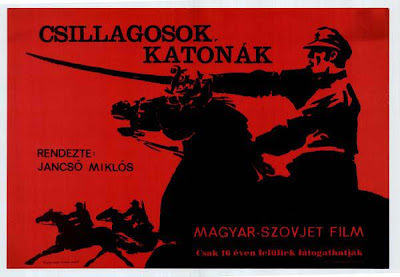A.K.A.: Csillagosok, Katonak
Country: Hungary / U.S.S.R.
Country: Hungary / U.S.S.R.
Genre(s): War
Director: Miklos
Jansco
Cast: Jozsef
Madaras / Tibor Molnar / Krystyna Mikolajewska
Plot
The Communist Red Army,
aided by Hungarian recruits, are at war with the Czarist White Army along the
Volga River. A hospital becomes a point of
contention during the fighting.
What I Liked
In so many war films,
we know from the start that the hero is going to survive, if not the entire
film, then until very late in the film.
In “The Red and the White,” not only are there no traditional examples of heroes, almost
every character the camera follows for more than a few minutes eventually bites
it in some unnecessary act of violence.
Very often the story follows one character until his or her demise and
then follows that person’s executioner until that person too meets a senseless end. Thus “The Red and the White” defies convention of with its arbitrary deaths. For exemplifying the absurdity of war, the
only film that I’ve seen that can compare is “Catch-22.”
Commissioned by the
Soviet Union to portray the glory of Communist victory, director Miklos Jansco
instead made a subversive film that uses the red versus white conflict as an
example of what can be assumed to be his message, that all war is ultimately
wasteful, ignominious, and dehumanizing.
Human beings are casually executed as though they are no more than
garbage being dropped down the disposal.
Even those being executed seem bored and indifferent to the killing, as
they just stand there, languid and expressionless, waiting for the bullet. Soldiers march about according to the orders
of their commanders, but seem to be moving toward nowhere in particular with no
objective. Sometimes they just wind up
back where they started, but at least they’re in formation. Civilians are herded around, divided, and
organized for what seems to be no other purpose than the gratification of the
military officers. Women are treated as
objects, stripped, humiliated, and raped by members of both sides in the
fighting.
Naturally, the repulsed Soviet government ended
up banning the very film they had financed.
What I Didn’t Like
Part of Jansco’s
approach to showing the dehumanizing effect of war is to keep close-ups and
personal dialogue to a minimum. Nearly
all of the shots are wide of landscapes, with groups of people moving about in
various directions. Thus we get to know
the individual characters very little and instead watch it all as objective observers. While I understood the director’s purpose
with this approach, I found it so dehumanizing that I really didn’t care about
anyone on the screen. And if I don’t
care about the people, why should it matter to me if they turn into
corpses? “The Red and the White”
ultimately comes off like a philosophy treatise, as opposed to a compelling motion
picture.
To be honest, I was
often lost as to what exactly was going on. Arbitrariness was again one of the filmmaker’s
purposes, but I was so confused that my only care was how much longer the
film would last so I could get my entry over with. Getting through this movie took me three
sittings and even then I was counting down the minutes. Ultimately, while I respected what Jansco
did, I didn’t care.
Most Memorable Scene
*spoiler alert!*
In perhaps the only
scene that has any kind of intimacy with the characters, a nurse and a soldier
come very close to making love when they are interrupted by the enemy on horseback. The resulting terror, humiliation, and brutal
death finally make the audience feel for the two lovers, just before we have to
say goodbye to one of them.
My Rating: 2 out of 5

No comments:
Post a Comment